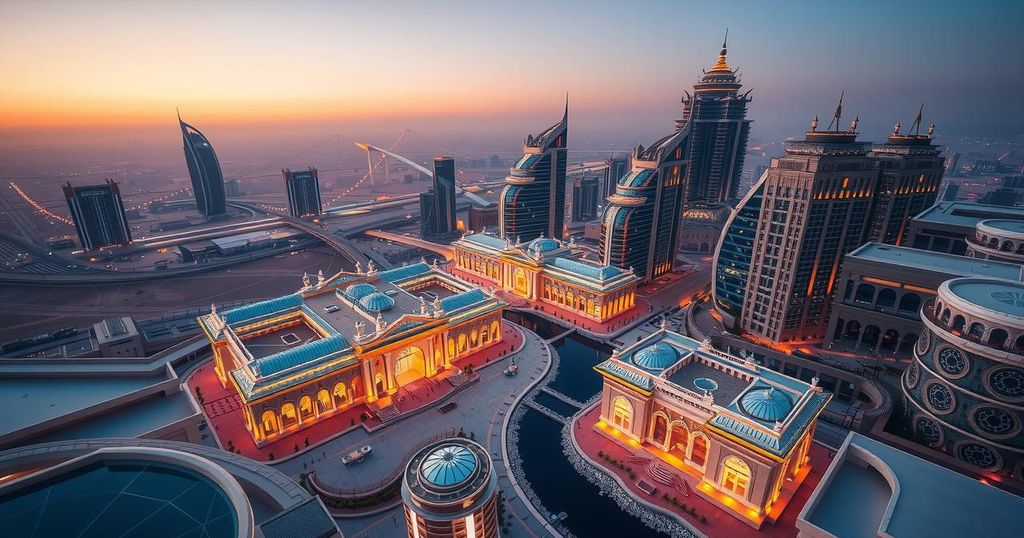Key Moments From Trump’s Recent Middle East Tour

President Trump has wrapped up a three-country Middle Eastern tour where he solidified key investment deals, signaled plans to lift sanctions on Syria, and discussed a nuclear deal with Iran. Highlights from the visit included a monumental arms deal with Saudi Arabia and controversial discussions about U.S. involvement in Gaza. Overall, the trip marked significant policy shifts that may affect U.S. relations in the region moving forward.
President Donald Trump has concluded a busy tour of the Middle East, having visited three countries in just a few days. His visit was marked by significant geopolitical maneuvers, possibly reshaping the United States’ role in the region. Key highlights included the first U.S.-Syria presidential meeting in 25 years and discussions on a potential nuclear deal with Iran.
Trump kicked off his tour on May 13, landing in Saudi Arabia’s capital, Riyadh, where he was welcomed with much fanfare. During his arrival at the Royal Saudi Palace, he signed investment agreements representing billions across various sectors. Notable attendees included prominent business figures such as Tesla’s Elon Musk and OpenAI’s Sam Altman, indicating a strong focus not just on politics but also on business investments.
The next leg of Trump’s journey took him to Doha, Qatar, on May 14, where he established more agreements including a substantial $96 billion deal with Boeing. This visit also saw him revisit the controversial idea of the United States assuming control over Gaza. After Qatar, Trump wrapped up his tour in the United Arab Emirates, sealing a significant $1.4 trillion agreement focused on artificial intelligence.
Reflecting on his tour, Trump speculated that future administrations could claim credit for his achievements. He remarked during a flight back to Washington, D.C., “Somebody’s going to be taking the credit for this. You remember, press, this guy did it.”
One of the most notable developments was the announced $142 billion arms deal with Saudi Arabia. Saudi Crown Prince Mohammed bin Salman provided a high-profile welcome to Trump, signaling strong bilateral relations. This arms deal is the largest ever and represents a significant commitment to defense cooperation, with further focus on technology and energy investments reached between the two nations.
In an unexpected twist, Trump indicated plans to lift longstanding U.S. sanctions on Syria, which have been in place for over 45 years. This announcement was made during a U.S.-Saudi Investment Forum. While Trump labeled the sanctions as “brutal and crippling,” experts warned that the process of lifting such sanctions is complicated and involves multiple layers of governmental approval.
In a meeting in Riyadh, Trump spoke with Syrian President Ahmed al-Sharaa, urging him to normalize relations with Israel and combat terrorism in the country. Trump referred to al-Sharaa as a “young, attractive guy” with a strong past, suggesting he has the potential to stabilize Syria in the aftermath of the regime’s collapse.
Meanwhile, Trump’s plan to accept a luxury Boeing jet from Qatar, valued at around $400 million, stirred controversy in the United States. Critics argue that accepting such a gift raises serious ethical concerns. Senator Ed Markey proclaimed, “He’s going to turn Air Force One into Bribe Force One.” Trump defended his decision, asserting the plane is intended for the Air Force, emphasizing that only a fool would reject such a gift for the country.
While Israel was not on his travel agenda, Trump continued to discuss the Israel-Hamas conflict, expressing a desire for peace and stability for Palestinians by suggesting a U.S. takeover of Gaza to create a “freedom zone.” This controversial stance has not been welcomed by many global leaders.
The tour also had notable discussions about Iran, with Trump expressing a willingness to establish a new nuclear deal contingent upon Iran ceasing its terrorist activities and halting nuclear weapon development. Iranian officials responded, indicating a readiness to negotiate, but have stressed that uranium enrichment remains a fundamental right for their nation.
As Trump concluded his tour, he reiterated that Iran had received a proposal from the U.S. and hinted at urgent advancements required in discussions. “They know that they have to move quickly, or something bad, something bad’s gonna happen,” he stated, pointing to the complexities still ahead in evolving U.S.-Iran relations.
In summary, President Trump’s Middle Eastern tour was packed with diplomatic talks, controversial decisions, and historical agreements. From securing billions of dollars in defense contracts with Saudi Arabia to exploring the prospect of lifting sanctions on Syria, the trip has the potential to significantly impact future U.S. foreign policy in the region. Trump’s remarks about a possible U.S. role in Gaza and negotiations with Iran reflect the complexities of Middle Eastern geopolitics that the new administration will inherit. While the outcomes of this whirlwind visit remain to be fully realized, it undeniably set the stage for future diplomatic engagements and challenges.
Original Source: time.com





